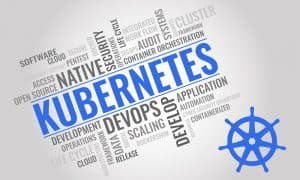
The Kubernetes-enabled enterprise software wake-up call should not be overlooked, especially for those in the C-suite responsible for future-proofing business operations.
Kubernetes is a powerful enterprise software development and a key enabler for what has become an essential strategy for cloud computing, containerization. The fast-growing preference for open-source technology facilitates the containerization method that makes configuring systems more straightforward and software deployment faster, all while increasing reliability and enhancing the efficiency of compute resources. Kubernetes is taking on an essential role in enterprise software development.
Predictions from Gartner place Kubernetes at the forefront of enterprise software development, claiming that 70 percent of global organizations will be operating with more than two containerized applications by 2023—up from the 20 percent in 2019. Kubernetes introduces real advantages, unlike other provisioning software methods, such as virtual machines, meaning a real showcase of deployment, scaling, and management capabilities. Through a cohesive use of Kubernetes as part of an enterprise technology stack, the gates for vital new productivity and profit margin gains can be opened.
See also: Mitigating Kubernetes Security Gaps
Shedding light on Kubernetes technology versus VM
A recent VMware study found that 95 percent of participants recognized benefits from Kubernetes, with 56 percent explaining that they experienced improved resource utilization—signifying a reduced spend on the private or public cloud compute resources that naturally house enterprise applications. An additional 33 percent of respondents said Kubernetes delivered lower public cloud costs.
Virtual machines are one of the most prevalent forms of provisioning software, with each machine including a guest operating system, a copy of the software it provisions, and a hypervisor to assign computing resources across various operating applications and systems. All of these different components consume system resources. Virtual machines are relatively stagnant, meaning it is hard to move them back and forth between on-premises servers, private clouds, or the public cloud.
A containerized software application runs on an external operating system, so it will reduce the number of compute resources needed to run the multiple guest operating systems. In many circumstances, a company may be able to activate multiple containerized applications on the server resources that previously could only accommodate one application. Central tools within the container manage how these applications use server resources, so when combined with the fact that there is no multiple operating systems left to manage, administrative overheads are significantly reduced.
But here is the crowning achievement—the start-up time for containerized applications with Kubernetes is remarkably faster than those on a virtual machine, significantly improving user engagement and time efficiency—in milliseconds rather than minutes.
Enterprise stack update: can software keep up?
Kubernetes have instant scaling network abilities, which are widely valued by enterprise IT experts, a sought-after capability considering the increasing unpredictability of business and market environments. Rapid changes in demand for products or services can often be limited by finite compute resources from enterprise architecture that cannot scale quickly enough, leading to lost business, a poor customer experience, or even business failure.
Constantly changing or resetting processes and requirements is now more important than ever as the “set it and forget it” days of ERP or other enterprise technology roll out become a bygone. Now, acquired divisions, changing customer demands, dynamic go-to-market strategies, and the introduction of disruptive technologies such as the internet of things (IoT), artificial intelligence (AI), and augmented/virtual reality (ARVR), all mean the enterprise stack must be updated on an increasingly regular basis.
Accelerated development cycles get a head start
Results from the VMware study show that 53 percent of respondents agree that development cycles were made quicker by Kubernetes. Having Kubernetes rooted within an enterprise software platform can help providers fast track the introduction of new software features and capabilities to the market and, therefore, into the hands of customers. In exchange, businesses themselves can quickly adapt to changes in the market and governing environment and even turn that agility into a competitive advantage, beating rivals to market or course-correcting faster than they can.
The integration of cloud takes off
In the meantime, the inevitable move of business systems to the cloud continues. In 2019, we conducted a study of 600 business decision-makers from around the world to assess cloud migration progress and strategies. When we compared that data with data from a similar IFS study in 2012, the percentage of companies now relying on various forms of cloud enterprise software provisioning almost doubled, while the percentage of companies with on-premises solutions almost halved.
But in a cloud-first environment, executives still recognize certain scenarios favor on-premises deployment or even need to be moved back and forth between public cloud, private cloud, or on-premise. Equally, an on-premises or private cloud application may need to seamlessly make use of compute resources in a public cloud to handle peak or hockey stick demand. Kubernetes enabled applications just make this simpler.
Settling on a plan of deployment – practical choices to suit business needs
Kubernetes can help orchestrate containerization in an assembly of environments, including hosting software on a vendor’s cloud, self-hosting by a business, or in a hybrid environment where the core application stack is self-hosted. But several of the application services are accessed as cloud services run by the software vendor. The hybrid option allows businesses to offload some of the deployment complexity.
This means functions that might be better held closed – rather than placed in a public or even private cloud due to regulatory or practical considerations – can be run on-premises or wherever is most suitable for the customer. That instance of software can be augmented by services from the software vendor ranging from reporting, optimization engines, cognitive services, and more. Thanks to Kubernetes, different parts of the application can be run from separate servers – on-premise, private cloud, public cloud – all depending on what makes sense to the end-user.
Security is the foundation of deployment
The use of Kubernetes within the software stack as a container orchestration tool will ensure essential security provisions are well respected throughout the change. One benefit of containerization is the ability to quickly move new software into production, enabling rapid change and digital transformation. But as every CIO will appreciate, with new deployment comes new security issues—rules and policies must be enforced as the application changes. Which external device or system is authorized to access the software? Which users are enabled to view and interact with which data? Which roles in the organization have which access permissions? This scale of management is easier if security is addressed early in the software development process—which means there are security benefits if Kubernetes and containerization are delivered as part of a packaged software application.
The most advanced enterprise software applications will gradually own the Kubernetes container orchestration process in ways that automatically respects the security and permissions reflected in the application as a whole. Enterprise applications will deliver the software services in the form of Docker containers, orchestrated by Kubernetes. This will provide the scaling benefits of having regional Kubernetes clusters serve multiple customers, and the software vendor will ensure the application retains full separation and privacy of customers’ solutions through the use of customer-specific Kubernetes namespaces, network separation, encryption, and database instances. Enterprise software vendors not intent on selling their own proprietary technology can make use of packaged Kubernetes environments such as Microsoft Azure Kubernetes Service in their technology stack.
Kubernetes continues to make headway
The Kubernetes-enabled enterprise software wake-up call should not be overlooked, especially for those in the C-suite responsible for future-proofing business operations. As enterprise software becomes progressively more cloud intuitive, businesses are required to continually alter their processes—Kubernetes top seat at the table is surely without challenge – it offers the scalability, security, and flexibility to practically adapt to these changes.




























